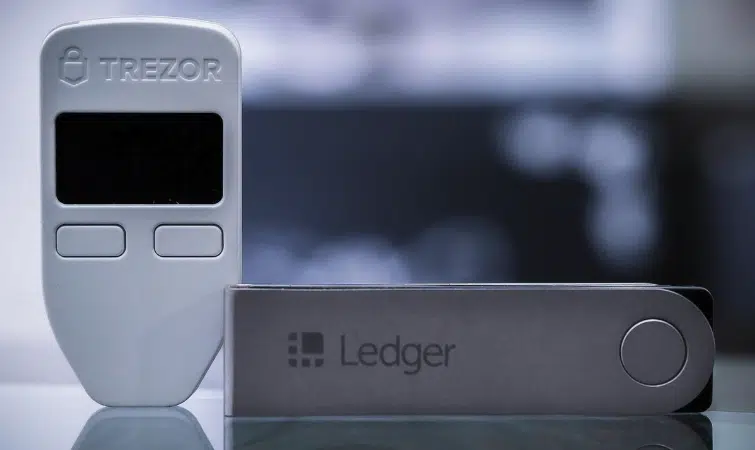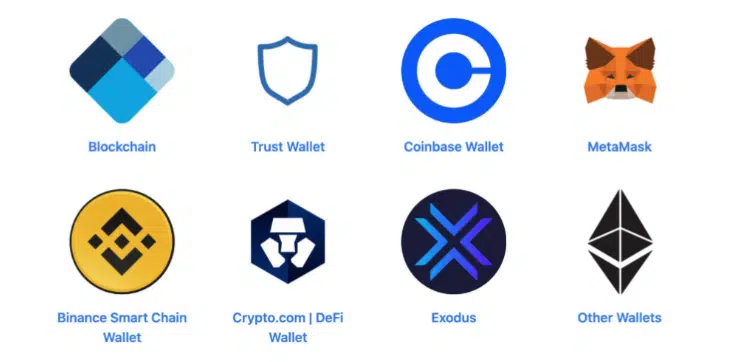TLDR
This guide will explore the main difference between cold and hot wallets. It will include different types of cryptocurrency wallets and their pros and cons.
A cryptocurrency wallet is a digital wallet that makes it easier to send, receive, and store digital currencies on blockchains. It lets users securely keep their private keys on crypto exchanges and perform financial transactions using their crypto assets.
Cryptocurrency wallets can be either hot storage (online) or cold storage (offline); the main difference is the internet connection. The choice between a hot or cold wallet for cryptocurrency depends on the user’s security needs and the frequency of transactions.
Hot Wallet
As a cryptocurrency wallet with internet connectivity, a hot wallet actively facilitates frequent transactions. It also provides access from anywhere an internet connection is available. The private keys reside on an internet-connected device, such as a mobile phone or computer, which holds the hot wallet.
An example of a hot wallet is Metamask or Trustwallet connected to a Web 3 platform on the Internet.
Hot wallets are easier to use and more accessible because they are connected to the Internet but also more susceptible to hacking and cyber-attacks.
Cold Wallet
In contrast, a cold wallet, a cryptocurrency wallet disconnected from the internet, offers enhanced safety. A device not connected to the internet, such as a USB drive or hardware wallet, securely houses the private keys of a cold wallet.
An example of a cold wallet would be Ledger or Trezor wallet.
Large quantities of cryptocurrency are best stored and secured using hardware wallets. However, they are less accessible and need physical access for transactions.
If choosing an ideal hot wallet is hard, it is even harder to choose a cold wallet. The reason is that most of them are not free, and choosing the wrong one would result in wasting money.
Thus, here are the top cold wallets in 2024, together with their features and pros and cons.
More details
The Ledger Nano X is a must-have, secure hardware wallet for cryptocurrency. It features easy mobile pairing, a sleek design, Bluetooth support, and robust security features like a safe chip and two-factor authentication.
-
Supports 5500 various cryptocurrencies.
-
Private keys are encrypted.
-
Desktop and mobile devices are supported.
-
Bluetooth enabled.
-
Allow 100 apps storage.
-
Fairly overpriced against the competition.
-
Only 100 apps are allowed.
-
Bluetooth works solely with mobile.


More details
Ledger Stax is the markets most stylish cryptocurrency hardware wallet with NFT customized lock screen, user-friendly touchscreen, Bluetooth-enabled device and supports 5500+ altcoins. Its Qi charging technology makes a single last for months.
-
Large-sized e-ink screen for easy usability.
-
Bluetooth-enabled connectivity.
-
Sturdy and transportable case
-
Best design in the industry.
-
Higher cost than its competitors
-
Restricted scalability selection.
-
Not broadly adopted.
More details
Ngrave Wallet provides utmost security and a user-friendly experience. Its offline functionality, EAL7-certified OS, multi-crypto support, intuitive interface, and robust security make it a top choice for secure crypto asset management.
-
Advanced security features.
-
Interface with a 4-inch touchscreen.
-
Over 1000 cryptocurrency support.
-
Trusted certification (EAL7).
-
Limited support for decentralized finance (DeFi).
-
Higher price range compared to other wallets.
-
Lack of Bluetooth and NFC connectivity.


More details
The Trezor Model T is a high-quality hardware wallet that offers top-notch security for cryptocurrency investors. Trezor is known for its transparency and trustworthiness. The ability to store 1500+ tokens and Non-Fungible Tokens (NFTs) justifies the premium price of $219. However, some users have reported issues with the MicroSD card slot. Trezor Model T is a solid pick to safeguard crypto despite minor concerns.
-
It supports 1400+ crypto assets.
-
Touch screen for a user-friendly operation.
-
It supports NFTs storage.
-
Too expensive when compared to its competitors.
-
It has limited mobile compatibility.
-
A bulky design that is quite hard to carry around.
Hot Wallet vs. Cold Wallets: Main Differences
There are various factors to compare Hot Wallet and Cold Wallet, some of which are security, accessibility, ease of use, cost, and purpose. Let’s look at them one by one.

1. Security
First up is security in the hot wallets vs. cold wallets
Security is a primary concern when it comes to cryptocurrencies. A hardware wallet/cold wallet is among the best ways to safeguard digital assets.
Because it lacks an internet connection, a cold wallet is considered safer than a hot wallet. This guarantees that user data is safe, secure, and impervious to hacking or online attacks.
Users who desire extra protection use cold wallets, as these provide safety from potential hackers by storing them in cold storage wallets.
The offline storage of the private keys makes it nearly impossible for hackers to access them. Users can move funds into and out of their cold wallets without being intercepted by malicious parties.
Because they are linked to the Internet, hot wallets are less secure than hardware wallets. This implies that hackers will easily access a hot wallet’s private keys if they find flaws in a user’s network or device.
Malicious actors can also use phishing techniques. This is done by building fake websites that mimic real exchanges or services to trick unwary users into providing their user credentials.
2. Accessibility
Let’s look at the accessibility between a hot wallet VS. cold wallet.
Since users can easily access their funds from any location with an internet connection, Hot wallets are accessible.
To an extent, the asset is safe and secure with hot wallets since each transaction requires authorization from a unique private security key.

Hot wallets also provide users with accessible real-time data on individual coins to quickly monitor their finances.
Typically, a cold wallet doesn’t have an internet connection and operates in an offline setting. Therefore, only tangible transmission methods, like a USB drive, QR code, or paper backup, can add or remove funds from a cold wallet.
This implies that to send and receive digital currencies. A user must physically have a mobile crypto wallet or access the wallet via hardware devices.
3. Ease of Use
Let’s review the ease of use between hot wallet vs. cold wallet.
Hot wallets provide a user-friendly interface that enables transactions to be completed without comprehending the intricacies of blockchain technology.
These digital wallets are available on PC and mobile applications, allowing users to manage their crypto assets on the blockchain network in real-time.
Since cold wallets are not online, any other cold storage device that stores user crypto assets must be secure and protected to protect against potential hackers and malicious malware.

Cold wallets often fall into two categories: hardware-based (such as USB drives) or paper-based (such as printed sheets).
Since it’s essential for creating and managing private keys, the latter typically necessitates a higher level of technical understanding of how digital currency functions. Therefore, advanced users who understand cryptography and can adequately secure their assets offline are best suited for cold wallets.
4. Cost
Now, let’s look at the costs between the two wallet types.
Unlike hot wallets that are either cloud-based or installed on smart devices, cold storage solutions usually require additional hardware for secure storage.
USB sticks and hardware wallets are typical examples of cold wallets. The small storage device known as a USB stick drive can store crypto keys offline, making them inaccessible over the Internet.
Hardware crypto wallets are tangible objects that resemble USB drives but have additional encryption capabilities. These devices come in various sizes and designs, with varying levels of security based on the user’s needs and budget.
Hardware wallets typically range in price from $50 to $150. However, since crypto keys may be kept on paper, there are ways to create free cold wallets, which will also be discussed in this article.
The most popular type of hot wallet is a software wallet, which can be downloaded and installed on a computer or mobile device. Downloading, installing, and using the wallets is always free.
5. Purpose
Lastly, what is the purpose of choosing the right wallet for you?

Due to their simplicity of use and the speed at which transactions may be performed, hot wallets are ideally suited for short-term cryptocurrency storage and fast transactions. Hot wallets are also excellent for storing tiny amounts of cryptocurrency daily.
Because they offer additional security from internet dangers like hacker and malware attacks, cold wallet storage solutions are perfect for the long-term storage of cryptocurrency assets. This would be the ideal storage method for your crypto funds.
How to create a cold wallet?
Creating a cold wallet is simple and similar to creating most hot wallets. Creating hot wallets requires you to download an app specific to a particular blockchain, so you are creating a cold wallet or hardware wallet.
Numerous cold wallets are available, and anyone interested can find the documentation on the official websites or associated wallet pages.
Below is a quick run-through of how to create a Bitcoin cold storage wallet:
Creating a pair of private/public keys
Making an offline Bitcoin address is the first step in storing your Bitcoin in cold storage. The “public/private key pair” associated with this address will be generated entirely offline.
A public/private key pair is comparable to an e-mail address and the password that goes with it. This key pair should never be shared online to maintain the highest level of security in storing cryptocurrency.

Before generating the keys, you need to use either web page if you are generating for Bitcoin (BTC).
Setting up your cold storage paper wallet is relatively straightforward and requires no technological expertise.
The only “hard” part is that you must save the Web page that generates the keys, turn off Internet access on your device, open the saved webpage on your desktop, and generate the keys.
This method guarantees that your cold wallet’s private and public keys have never been exposed to the Internet.
Let’s see how you can safely store your private key.
Print the page
The next step is to create an offline copy. To add Bitcoin to your wallet later, use the public key (also known as the address), and if you wish to spend the wallet’s contents, use the private key (also known as the password) to sign transactions.
Print out the public/private key pair to create an offline copy. You can certainly jot down the key pair on a piece of paper. However, if you’re sure that neither your printer nor your computer is connected to the internet, feel free to click the print button. This method eliminates the chance of making mistakes when transcribing a long string of random numbers and letters.
Add funds to the wallet
Sending Bitcoin to the address displayed on the printed wallet in alphanumeric and QR code form is the only step necessary to fund your new paper wallet because it has a public address, just like every other cryptocurrency wallet.
Redeem Bitcoin from your cold wallet
When you are prepared to withdraw funds from your cold storage wallet, you must import the wallet’s private key into a “hot” (online) Bitcoin wallet. Any wallet that permits the import of private keys is compatible. For instance, using the Bitcoin.com Wallet is as simple as tapping ADD/IMPORT and following the prompts.
Any amount you previously sent to the paper wallet is now available for use once you have successfully imported it to your “hot” wallet.
Note: Never use a cold storage wallet again. Once you’ve used them online, repeat the steps above to make a new wallet if necessary.
How does this work?
The tools mentioned above are client-side address generators. Through your browser, they generate local Bitcoin key pairs for the public and private keys. The advantage of this method is that you can locally load JavaScript and be confident that it did not change after being loaded.
Since the tools are open source, anyone can view the code whenever they want.
Other cold storage wallet options

Experience the convenience of cold storage wallets, such as desktop or cold storage devices, which require a connection to your computer or mobile device without an internet connection.
Is a cold wallet worth the investment?
Compared to alternative cold storage options, cold wallets might be expensive when using physical devices. Still, the expense is justified for those serious about safeguarding their cryptocurrencies from theft or hacking. They are made with an additional layer of security, like a PIN code, to protect user assets from illegal access.
Additionally, various cold wallet devices have built-in capabilities like backup seeds that help protect user data against loss or damage due to a dysfunctional device or physical damage so that crypto users will not lose access to their public/private keys stored offline.
Popular hot wallets

Hot wallets are the most used digital wallet in the crypto space for executing crypto transactions. They only require generating a seed phrase and wallet address. Despite being online, some of them have good security measures in place.
Some popular hot wallets include online and mobile wallets such as the Coinbase wallet, Edge wallet, Robinhood, Trust wallet, Metamask, blockchain, etc.
Importance of Choosing the Right Wallet
Making the appropriate wallet choice is crucial to keeping your cryptocurrency safe, secure, and easily accessible. When choosing a cryptocurrency wallet, either a hot or cold wallet, take into account the following factors:
You should first and foremost evaluate your own needs. Do you intend to keep different kinds of digital currencies? Do you favor hardware wallets over web-based wallets because they are more secure? Consider how frequently you will use this wallet; if frequently, a full mobile wallet or app may be more appropriate than desktop software.
Additionally, consider what security features, such as multi-signature accounts or two-factor authentication.
Conclusion
Finally, both hot and cold wallets are reliable choices for holding cryptocurrency. Cold wallets provide the highest level of security because they don’t need an internet connection and are typically harder to hack. On the other hand, hot wallets offer greater convenience and quicker transaction times.
In the end, users need to consider their preferences and needs when deciding between a cold wallet and a hot one.
Luckily, we have made a comprehensive list of the best cold wallets and more insight and tips on crypto-related topics.
Despite their disconnection from the internet making cold wallets generally safer than hot wallets, they aren't completely secure either. Storing crypto keys offline can leave them vulnerable to malware. Furthermore, hackers have developed various attacks that could compromise your hardware wallet's private keys.
Conversely, a hot wallet provides a higher level of security features than a cold wallet, offering a more secure method of online cryptocurrency storage. Meanwhile, a cold wallet, completely disconnected from the internet, is typically used for storing and holding funds.
Users may find their bitcoin and other cryptocurrency tokens at risk due to theft, computer failure, loss of access keys, and more. Cold storage, or offline wallets, present one of the safest methods for holding bitcoin since they're not internet-accessible, though some users still find hot wallets convenient.
Users have the option to store keys in two main types of wallets: hot and cold. A hot wallet is typically connected to the internet and serves as a gateway to the blockchain, allowing users to issue transactions directly to the blockchain.










